 Last additions - Site Images Last additions - Site Images |

No Smoking on Street路上喫煙はやめましょう - This is "Rojō kitsuen wa yamemashō." It means please don't smoke while walking on the street.
Place: Street corner near a train station in Tokyo.May 28, 2005
|
|
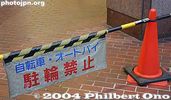
No Bicycle/Motorcycle Parking駐輪禁止 - "Chūrin kinshi" in red characters mean two-wheeled vehicles cannot park here. In blue characters, it says "jitensha" (bicycles) and "ōtobai" (motorcycles and motor scooters).
Place: Street corner near a train station in Tokyo.May 28, 2005
|
|

Beware of Wild Monkeys野生の猿にご注意 - "Yasei no saru ni go-chūi." "Yasei" means wild, and "saru" is monkey. Japan has a substantial population of wild monkeys which can be very aggressive in foraging for food, especially at tourist spots. They often steal food (sweets, etc.) from tourist shops and commonly grab any paper or plastic bag that you are carrying. If you see wild monkeys, you should not feed them nor carry any bags with your hands.
The sign also says "We cannot be responsible for any accidents caused by wild monkeys."
Place: Mt. Hiei Driveway, Kyoto.May 28, 2005
|
|
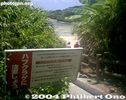
Beware of Jellyfishハブクラゲに注意しよう! - "Habu kurage ni chūi shiyō." Beware of jellyfish. In Okinawa, "habu kurage" (Chiropsalmus quadrigatus) is a type of poisonous jellyfish whose venomous sting can cause death.
Place: Taketomi island, Okinawa.May 28, 2005
|
|
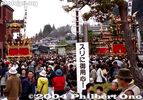
Watch Out for Pickpockets!スリに御用心 - Another human animal to watch out for. "Suri ni go-yōjin!" means watch out for pickpockets! "Suri" means pickpocket, and "go-yōjin" is like "chūi."
Place: Takayama Festival, Gifu Pref.May 28, 2005
|
|
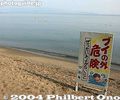
Do not Go Beyond the Buoysブイの外 危険 - It reads "Bui no soto kiken" which means "Dangerous to go beyond the buoy." The buoys in this case are the brightly-colored floating balls that mark the outer boundary of the safe swimming area. The water is usually too deep or the waves are too dangerous beyond this boundary. Almost all swimming beaches in Japan have some kind of outer boundary.
Place: Northern Lake Biwa, Shiga Pref.May 28, 2005
|
|
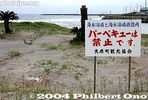
No BBQバーベキューは禁止です - The characters in red say, "barbecue wa kinshi desu." Having a barbecue is prohibited.
Place: Ohara beach, Chiba Pref.May 28, 2005
|
|
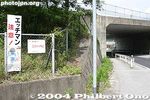
Beware of Flashers!エッチマン注意! - Besides watching out for poisonous snakes, jellyfish, and wild monkeys as you saw in the previous images, there's one last wild animal to watch out for: the flasher. Apparently, this country neighborhood has had a flasher (a person who shows his genitals) so often that they put up this sign to warn female passers by.
The sign reads "H man chūi!" "H" is for "hentai" meaning pervert. "Man" is man, and you know what "chūi" means.
Place: Country road, northern Shiga Pref.May 28, 2005
|
|
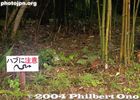
Beware of Habu Snakesハブに注意 - "Habu ni chūi." Finally we see the third most common word on warning signs: Chui, meaning "beware of" or "watch out for." Habu is a species of poisonous snake common in Okinawa where this picture was taken.
Place: OkinawaMay 28, 2005
|
|

Take Off Your Shoes土足厳禁 - It says "Dosoku genkin" or footware prohibited. "Dosoku" literally means dirty feet, and "genkin" is like "kinshi," meaning prohibited. So we have to take off our footwear before going up the stairs to see the second floor of this museum.
In most places, it will be obvious that you have to take off your shoes before entering the castle, museum, temple, etc. At the entrance hall, you will see a shelf to store shoes and indoor slippers lined up on the floor.
Place: Azuchi, Shiga Pref.May 28, 2005
|
|
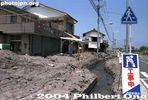
Under Construction工事中 - The sign reads "Kōji-chū" meaning "under construction." You see this often at Japanese Web sites as well.
Place: Near Mt. Fugendake, Nagasaki Pref. (Note that the year stated in the image indicates the year the photo was first published, not the year when the picture was taken.)May 28, 2005
|
|

Danger! Do not Jump in River危険!川へ飛び込まないでください。- The red characters read "Kiken!" (Danger!), and the black characters say "Kawa e tobi komanaide kudasai." "Kawa" is river, "tobi komi" is to jump or dive in.
This at the famous Dotonbori canal in central Osaka where it is a popular place for fanatical baseball fans to jump in whenever the local baseball team (Hanshin Tigers) wins big. The river is quite polluted and littered with trash (though recently cleaned up by the city). During the Soccer World Cup in 2002, several hundred people jumped in the water when the Japan team won a crucial game.
Place: Dotonbori, Osaka.May 28, 2005
|
|

No Swimming遊泳禁止 - By now you must be getting sick of seeing this word "kinshi." Well, it's certainly not a pleasant word since it limits your freedom. But it also serves to keep you safe. The kanji in red reads "yūei kinshi" meaning "swimming (and playing in the water) prohibited." Below in black reads, "Koko wa suieijō dewa arimasen." This is not a place for swimming.
Place: Lake Biwa at Otsu, Shiga Pref.May 28, 2005
|
|

Go Slow徐行 - The sign on the right says "Jokō" meaning go slow (when boarding or disembarking from the ferry). You may see this at construction sites as well.
Place: Onomichi, Hiroshima Pref.May 28, 2005
|
|
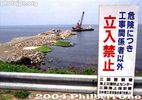
Do Not EnterThis sign is similar to the preceding one. The middle column of characters has the word "kōji" (工事) which means construction. So the sign means, "Danger: No entry except for authorized construction workers."
Place: Mikuni-cho, Fukui Pref.May 28, 2005
|
|
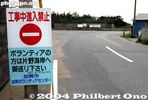
Under Construction - Do Not Enter工事中 - Another variation of "Do not Enter." The red characters read "Kōji-chū shinnyū kinshi" meaning no entry during construction operations. The "No entry" traffic symbol is also a tell-tale sign. You usually see this symbol at the entrance of a one-way road (if you face the wrong direction).May 28, 2005
|
|
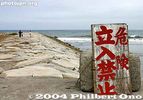
Danger, Keep Out危険 立入禁止 - The kanji characters on the right say "kiken" meaning danger. The big characters on the left say "tachi-iri kinshi" meaning "entry prohibited." Remember the word "kiken" (危険). It is one of the three most common words on warning signs in Japan. Another one is "kinshi" (禁止). If you see it, be aware that something is prohibited.
Place: Ohara beach, Chiba.May 28, 2005
|
|

Do not Enter立入禁止 - Another "entry prohibited" sign or "tachi-iri kinshi" in red kanji characters. On the right, the characters read, "kankei-sha igai" meaning "unauthorized persons."
Place: Lake Biwa at Otsu, Shiga Pref.May 28, 2005
|
|

No Photography撮影禁止 - The sign reads "Satsuei kinshi." "Satsuei" means to take photos, and "kinshi" means "prohibited." The "No photo" symbol also makes it clear.
On Japanese warning signs, the three most common words you will see are "kinshi" (禁止), "kiken" (危険), and "chui" (or "go-chui") (注意). They respectively mean "prohibited," "danger," and "beware of."
Place: World PC Expo in Makuhari Messe in Chiba.May 28, 2005
|
|

No Tripods三脚使用禁止 - The bold characters read, "Sankyaku shiyō kinshi" meaning tripod use is prohibited. The sign further explains that since tripods hinder the view of other spectators, they are not allowed except in the press photographers' box.
The kanji characters for tripod consists of "san" for three (the 3 horizontal lines make it obvious), and "kyaku" which means legs.
Place: Tsurugaoka Hachiman Shrine (during the Yabusame Festival), Kamakura, Kanagawa Pref.May 28, 2005
|
|

No Tripods and Monopods, unless...三脚 一脚 - This sign says "Sankyaku, ikkyaku go-shiyō no kata wa, kyokasho (2,000 yen) ga hitsuyō desu." Since you learned the characters for "tripod" in the preceding image, you should also know the characters for monopod, called "ikkyaku," literally "one leg."
This sign is a warning and a money-making scheme. It says that you cannot use a tripod or monopod in this garden unless you pay 2,000 yen to obtain a permission slip.
Place: Heian Shrine Garden, Kyoto.May 28, 2005
|
|

No Photography撮影禁止 - Another sign that reads (top to bottom) "Satsuei kinshi." "Satsuei" means to take photos, and "kinshi" means prohibited. At this Shinto shrine, you are not allowed to photograph inside the main shrine building housing the altar.
Place: A shrine in Kyoto.May 28, 2005
|
|
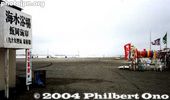
Swimming Beach海水浴場 - The sign on the left reads "Kaisui Yokujō." "Kaisui" literally means ocean water, and "yokujō" is bathing place.
Place: Kujukuri beach, Chiba Pref.May 28, 2005
|
|

This Week's Recommendations今週のおすすめ - The top string of characters say "Konshū no Osusume." "Konshū" is this week, and "osusume" is recommendation. You might see such a signboard in train stations. It publicizes major events and travel to those places. In this case, the Tenjin Matsuri (festival) in Osaka, the Hasu Matsuri (Lotus Flower Festival) in Kusatsu, Shiga Pref., and the Yosakoi Hyogo Festival in Kobe.
Place: A JR train station in the Kansai area.May 28, 2005
|
|

Stone Buddha石仏 - The characters read "Sekibutsu." "Seki" is stone, "butsu" is Buddha. This small stone buddha was one of several embedded on a series of stone steps leading to the castle tower.
Place: Azuchi Castle Ruins, Shiga Pref.May 28, 2005
|
|
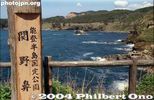
Quasi-National Park国定公園 - On this sign post, the smaller characters on the right read "Noto Hant? Kokutei K?en." "Noto Hantō" means Noto Peninsula, and "Kokutei Kōen" means Quasi-National Park. The word "hantō" literally means half island.
A quasi-national park is like a second-tier national park. The top-ranking national parks called "Kokuritsu Kōen" are defined to be natural areas of beauty rated as world-class. Meanwhile, the quasi-national park is not regarded as "world-class," but it is still beautiful enough to be designated as a national park. The large characters on the left say "Sekinohana," the name of this scenic coast.
There are over 50 quasi-national parks in Japan. In addition, there are prefectural parks designated by the local governor. These are areas of natural beauty recognized by the prefecture, but are not as magnificent as national and quasi-national parks.
Place: Noto Peninsula, Ishikawa Pref.May 28, 2005
|
|
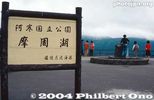
Lake Mashu湖 - The large characters in the middle is "Mashū-ko" or Lake Mashū. The third character "ko" means lake. Names of lakes almost always ends with this word. Lake Mashū, one of the cleanest and most transparent lakes in Japan, is within a national park called "Akan Kokuritsu Kōen" as indicated by the small characters at the top.
Place: Lake Mashū, HokkaidoMay 28, 2005
|
|

Fortune-telling Noteおみくじ - "Omikuji" is one way Shinto shrines make money. You pay a small fee and you receive a small paper note with a fortune inside.
Place: Heian Shrine, KyotoMay 28, 2005
|
|

Eight Scenic Views of Omi近江八景 - This sign post indicates that this place is a Scenic Spot ("Meishō" in the red characters). The scenic spot is one of the Eight Scenic Views of Ōmi or "Ōmi Hakkei." And this Ōmi Hakkei is Night Rain at Karasaki.
Ōmi (also spelled Ohmi) is the former name of Shiga Pref. During Japan's feudal era, there were a few hundred fiefs each having a name. These fiefs were eventually consolidated into the current 47 prefectures. Thus, each prefecture consists of one or more old feudal domains. The names of these old fiefs are commonly used in present-day place names within the prefecture.
Famed woodblock artist Hiroshige visited Ōmi and drew these eight scenic places immortalizing the term "Ōmi Hakkei," an idea that came from a lake in China. There are other similar names such as "A Hundred Views of Mt. Fuji" made famous by woodblock print artists.
Place: Karasaki at Lake Biwa, Shiga Pref.May 28, 2005
|
|

Peace平和 - "Heiwa" is another word you will hear often, especially in Hiroshima, Nagasaki, and Okinawa. The first two characters on the left read "Heiwa" followed by "ishiji" (cornerstone). (Ishiji is normally pronounced "ishizue," but they call it "ishiji" here.)
Place: Cornerstone of Peace, Okinawa. This is a memorial park with many black slabs of stone inscribed with the names of the 200,000 people (all nationalities) who died during the Battle of Okinawa during World War II.May 28, 2005
|
|

Castle城 - "Shiro" (or oshiro) means castle, but when it is appended to a name of a castle, it is pronounced "jō." Such as Kaminoyama-jō in the above example.
Also, if you're Okinawan, you would be familiar with this kanji because many Okinawan names have it. For example, Oshiro, Miyashiro, Kaneshiro, etc. The kanji can also be pronounced "gi" as in Miyagi (think Karate Kid movie).
Place: Kaminoyama Castle, Yamagata Pref.May 28, 2005
|
|
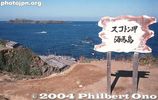
Cape岬 - Cape is "misaki" in Japanese. The sign says "Sukoton Misaki," or Cape Sukoton.
Place: Rebun island, HokkaidoMay 28, 2005
|
|
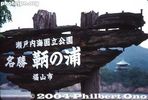
National Park国立公園 - As in many countries, Japan has areas of natural beauty designated as national parks called "Kokuritsu Kōen" (the last four characters on the sign's top line). The entire top line of characters reads, "Seto Naikai Kokuritsu Kōen." Seto Naikai is the Seto Inland Sea between Shikoku and Honshū islands. It is one of the first three areas in Japan to be designated as a national park in 1934. There are over 25 national parks in Japan. (See list at: http://www.env.go.jp/en/jeg/nps/pamph/index.html).
In the middle line (left to right), are two small characters "Meishō" or "Scenic Spot." The large characters is the place name, Tomonoura. Below this in small characters is Fukuyama-shi, the name of the city.
Place: Tomonoura (Fukuyama), Hiroshima Pref.May 28, 2005
|
|
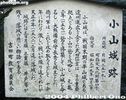
Castle Ruins城跡 - This is "jōseki," a kanji compound using "shiro" (see preceding image). The title's bottom two characters is "jōseki" meaning castle ruins. The top two characters is "Koyama," the name of this particular castle.
Place: Koyama Castle, Shizuoka Pref.May 28, 2005
|
|

Bicycles and Motor Scooters自転車/原付 - The left kanji characters (top to bottom) say "jitensha" (bicycles). On the right, it says "gentsuki" which is short for "gendōki-tsuki jitensha" (原動機付き自転車)or motor scooters.
Place: Island in the Seto Inland Sea.May 28, 2005
|
|
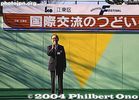
International国際 - Another word all overseas tourists in Japan should know: "Kokusai," the first two large, white characters on the left. It means international. It is followed by "kōryū" meaning exchange or interchange, and "tsudoi" or event.
Place: TokyoMay 28, 2005
|
|

Cherry Blossom Festival桜まつり - In big black characters is "Sakura Matsuri." "Sakura," of course, means cherry blossoms, and "matsuri" is festival. Above that in small characters is "Sumida Kōen" (Sumida Park) which is famous for cherry blossoms in Tokyo.
Place: Sumida Park, TokyoMay 28, 2005
|
|
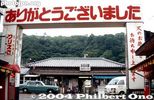
Thank YouIn big, red hiragana characters at the top is "Arigato gozaimashita." If you cannot even read this, it means you are totally illiterate in Japan. This big gate faces the pier where passengers get off the ferry and head for the train station right beyond this gate.
Place: Hama-Kanaya Station, Chiba Pref.May 28, 2005
|
|
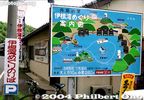
Bay Cruise Map伊根湾めぐり案内図 - The large white kanji characters at the upper left say "Ine-wan Meguri Annai-zu" or Ine Bay Cruise Guide map. When the word "meguri" follows the word for bay (wan) or any body of water, it means sightseeing boat cruise. This map, near the pier, shows the route of the sightseeing boat.
Place: Ine (Tango Peninsula), Kyoto.May 28, 2005
|
|

Bus Stopバス - At the top, the red katakana characters at the top says "basu" or bus. The word "noriba" (のりば)or "stop" is often appended to "bus." Below "Basu" is the name of the bus stop (Sumoto I.C.). "I.C." stands for "interchange" (on an expressway). Below that is the name of the bus companies stopping there (Tokushima Bus and Awaji Kōtsū).
Place: Awaji island, Hyogo Pref.May 28, 2005
|
|
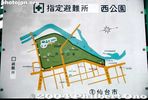
Emergency Refuge Area指定避難所 - What might look like another sightseeing map is actually a guide to the nearest emergency refuge area. It is usually a large park, and it is mainly for major earthquakes. The kanji characters at the top read "shitei hi'nan-jo" or designated evacuation area. The name of the park (Nishi Kōen) is further to the right.
Place: Sendai, Miyagi Pref.May 28, 2005
|
|

Cycling Roadサイクリング ロード - Above the bicycle symbol in green, it reads "Cycling Road." (Above that is "Shimanami Kaid?.") It is obvious that this is a path for bicycles.
Place: Island in the Seto Inland Sea. The Shimanami Kaidō is a roadway connecting several bridges spanning across a few islands in the Seto Inland Sea from Imabari in Ehime Pref., Shikoku to Onomichi in Hiroshima.May 28, 2005
|
|

You Are Here現在地 - Sightseeing and parking map. The "P" stands for "parking lot." Toward the bottom, the red kanji characters say "Genzai-chi" (You are Here).
Place: Minakuchi Castle, Shiga Pref.May 28, 2005
|
|

Public Toilet公衆便所 - Pronounced "kōshū benjo." And "WC" means "water closet." This is outside in the park. The men's/ladies' room inside a department store, etc., is usually called "otearai" (お手洗い).
Place: Sumida River fireworks, Tokyo.May 28, 2005
|
|
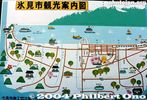
Sightseeing Map観光案内図 - You will often find a large sightseeing map right outside the train station. At the top, the last four kanji characters read "Kankō Annai-zu" meaning sightseeing guide map. Such maps are inexact and you cannot tell how far things are. The first three characters is the name of the city (Himi-shi).
Place: Himi, Toyama Pref.May 28, 2005
|
|

Store Your Bags一時預り所 - "Ichiji azukari-sho" means makeshift baggage storage place. This facility has been provided to accommodate the bags of the flood of visitors coming to see a big festival near this train station. The available coin-operated lockers are not enough. The "ichiji" can also mean one o'clock, but in this context, it means temporary.
The sign on the right says, "Ichinichi ikko 400 yen" and "Eigyō jikan 8:00 - 17:00." It costs 400 yen to store one bag, and the storage hours are as stated. The place requires you to come back for your stored bag by 5 pm. One advantage of the coin-operated lockers is that you don't need to come back for your bag by 5 pm.
Place: Shimo-Suwa Station, Nagano for the Onbashira Festival.May 28, 2005
|
|

Welcome!ようこそ - The red hiragana characters read "Yōkoso!" (Welcome!). The bottom characters say "Mother Bokujō e" (to Mother Farm).
(Note that all the Japanese kanji characters you see on signs will read either from top to bottom or from left to right.)
Place: Mother Farm, Chiba.May 28, 2005
|
|
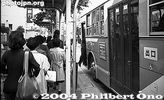
Exit出口 - The kanji characters beside the door says "Deguchi," meaning Exit. In this case, this door is only for exiting, not entering. (You enter the bus through the front door.) You will see "Deguchi" at train/subway stations as well.
Place: Bus stop in Tokyo.May 28, 2005
|
|

Train Station駅 - The kanji characters read "Sannomiya Eki." The last character "eki" is what you will always see in train and subway station names.
Place: Sannomiya Station, Hyogo Pref. (10 days after the Great Hanshin Earthquake in Jan. 1995).May 28, 2005
|
|

Tourist Information Center観光案内所 - "Kankō Annai-sho." A string of kanji characters any tourist in Japan should remember. "Kankō" means sightseeing, "annai" means guide, and "sho" is place. You can find sightseeing maps and pamphlets, sometimes in English.
Place: Local museum in the countryside.May 28, 2005
|
|

Photo Paper印画紙 - Pronounced "ingashi," it means photo paper, the kind you use in the darkroom. This is an ad from a camera magazine published in 1940. It advertises Sakura Photo Paper. The company was called Konishiroku (see bottom characters), the forerunner of Konica.May 28, 2005
|
|
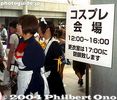
Costume Player Area, Tokyo Big Sight会場 - The sign says "Cosplay Kaijō" meaning Costume Player area (where you can pose for photographers). They are allowed to use it from 12 noon to 4:00 pm. And they even provide a dressing room (closes at 5 pm) for these costumers who attract visitors to the comic book show held there. Taken at Tokyo Big Sight.May 28, 2005
|
|

Self PrintingThe top characters says "Self Print" which means you can print photos yourself. On the red sign, it says that you can print from your digital camera or camera phone. However, when you look at all the little notes, there are so many things to keep in mind that you'd better ask the sales clerk to help you operate this machine. Before sticking in your memory card, better back up the data first.May 28, 2005
|
|

Commemorative Photo SignMt. Aso in Kumamoto Pref. This is a signboard graciously provided for "ki'nen shashin." You can stand behind this sign which says "Commemoration of Climbing Aso" with the date chalked in below it.May 28, 2005
|
|
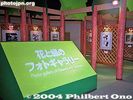
Photo Galleryフォトギャラリー - This is obviously "photo gallery." Above it is "Hana to Midori"(花と緑)meaning flowers and greenery. This was at the Lake Hamana Pacific Flora expo in 2004.May 28, 2005
|
|

Disposable Cameras写るんです - Next to a coffee machine on the left, this is a vending machine selling single-use cameras (or film with lens).
FujiFilm was the first to introduce these cameras (in 1986). Their single-use camera brand is called "Utsurundesu" (the red characters on the machine) meaning "it takes photos." It comes from the word "utsuru" which means capture (an image). It is also the first character in the word "shashin(写真).
Other film makers came up with their own cutsey names. These cameras, though, are on its way out as digital cameras and camera phones dominate.May 28, 2005
|
|

DPEDPE - Stands for Development, Printing, and Enlargement. We often find this at neighborhood photofinishers, but never at pro labs. The kanji after "DPE" is "uketsuke." The same characters as in the preceding picture.May 28, 2005
|
|
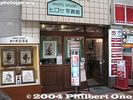
Portrait Studio写真館 - "Shashinkan" is portrait studio. In Japan, they call it "photo studio" which in real English could mean a rental studio used by a pro photographer to photograph products, models, etc. Also notice the "55-min." photo lab next door.May 28, 2005
|
|

55-min. PhotosThe term "one-hour photo" was once popular, but it seems "55 minutes" has taken over. Below the number "55" is the kanji for "fun" or minutes. Below that is "shiage" meaning "finished in." Thhe red katakana characters on the right says "Digital camera prints."May 28, 2005
|
|

Photo Lab Counter受付 - The last two characters on the large sign above is "uketsuke" meaning reception desk. This is a film processing counter inside a large camera store. The katakana characters before uketsuke say "Color Print." It's where to go to get your film processed.May 28, 2005
|
|

Portrait Studio Services写真館 - "Shashinkan" (the last three characters on the bottom line) is portrait studio. This sign is outside a portrait studio advertising its basic services.
From top to bottom:
Ki'nen shashin (記念写真): Literally "commemorative photo" which could be any kind of portrait--of family, children, etc., for any kind of occasion like coming-of-age day, graduation, etc.
Shutchō shashin (出張写真): Location shoot. A photographer can be dispatched to any location for any type of shoot such as wedding receptions, children's track meets, etc.
Shōmei shashin (証明写真): ID photos.May 28, 2005
|
|
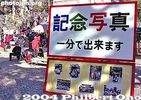
Commemorative Photos記念写真 - The top characters says "Ki'nen shashin." Ki'nen shashin is perhaps the most common photo term in Japan. Literally, it means "commemorative photo," but it has no real English equivalent.
It almost always show a person(s) you know and it's usually posed. They include family, friends, and yourself. It is a visual keepsake to record good memories. The picture answers the who, what, and where questions on a personal level such as travel photos, a meeting with the mayor, or at a friend's birthday party. It can be a casual snapshot or formal portrait.
This sign invites customers to have their photo taken by a pro photographer in front of this famous temple. The second line says "Ippun de dekimasu" meaning ready in 1 minute.May 28, 2005
|
|

Photo Booth証明写真 - "Shōmei shashin." This is another very common photo term in Japan. You often see it at camera shops, photofinishers, and on these photo booths.
This booth is emblazoned with "Shōmei shashin" in red characters. It means ID photos (for resumes, driver's license application/renewal forms, and passports). Of course, people often use it for fun too.May 28, 2005
|
|

Photo ServicesSign outside a portrait studio and camera shop.
From top to bottom:
1st line from top (red characters): Irrelevant (ignore it)
2nd line: Studio satsuei (portraits taken in the studio) and Shōmei shashin (ID photos).
3rd line: Irrelevant
4th line: Camera, yōhin (supplies), and album
5th line: Digital eizō shori (Digital-editing services)May 28, 2005
|
|
|
|